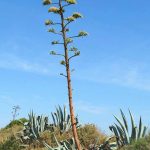 (Of an inflorescence) the lower unbranched part or stalk, as distinct from the rachis;
(Of an inflorescence) the lower unbranched part or stalk, as distinct from the rachis;
The general name for a flower stalk bearing either a solitary flower, a cluster or the common stalk of several pedicellate or sessile flowers. (I prefer to keep peduncle for the unbranched common stalk of the inflorescence, with branches called firstorder branch (or partialpeduncle), second-order branches etc.; and the main axis above the peduncle called just that or the rachis;
(In gymnosperms) the stalk which supports the cone;
[Old-fashioned usages] Linnaeus used peduncle for ‘the stem bearing flowers and fruit’ and pedicel for any ‘branch of the peduncle’; De Candolle used peduncle and pedicel in the same sense, but employed peduncle for parts nearer the base of the inflorescence, and pedicel for those nearer the top!
The stalk of a solitary flower, or the stalk which leads to an inflorescence.
The stem or stalk of a single flower or a whole floral cluster.
The stalk of a cluster of flowers.
The stalk supporting a single flower in an inflorescence.
The main stalk of a flower cluster, or the flower stalk when the plant is one-flowered; or when the flowers are single. The same distinctions pertain to the stalk of heads and clusters.
The stalk of an inflorescence or the stalk that supports the cone of gymnosperms.
The main supporting stalk of the whole inflorescence.
A term used to describe a narrow, stalklike piece of tissue. For example, the cerebellar peduncle is a narrow piece of tissue that connects the cerebellum with the brain stem.
A narrow process or stalklike structure, serving as a support or a connection. For example, the middle cerebellar peduncle connects the pons and cerebellum.
A stalk-like structure that usually acts as a support.
A slender structure that acts as a support or stem. This term often describes tumors that dangle from a stalk and specific aspects of brain anatomy.
